Financial Accounting Report: Regulations, Conventions, and Statements
VerifiedAdded on 2019/12/28
|41
|5576
|222
Report
AI Summary
This report provides a comprehensive overview of financial accounting, covering fundamental concepts, regulations, and practical applications. It begins with a definition of financial accounting, emphasizing its role in recording, reporting, and presenting financial performance, and highlights the importance of tools like balance sheets, income statements, and journal entries. The report then delves into the regulations governing financial accounting, including International Financial Reporting Standards (IFRS) and the Accounting Standards Board (ASB), outlining their impact on financial reporting and decision-making. It also explores key accounting principles such as the economic entity assumption, monetary unit assumption, full disclosure principles, going concern principle, and revenue recognition principle. The report further examines conventions related to consistency and material disclosure, providing guidelines for accountants. The report includes examples from client cases, demonstrating the preparation of journal entries, trial balances, profit and loss statements, and balance sheets. The report also analyzes the P&L statement of Rain Tree Ltd, demonstrating how to assess the company's profitability and financial health. This report provides a detailed understanding of financial accounting practices and their implications for business operations and decision-making.
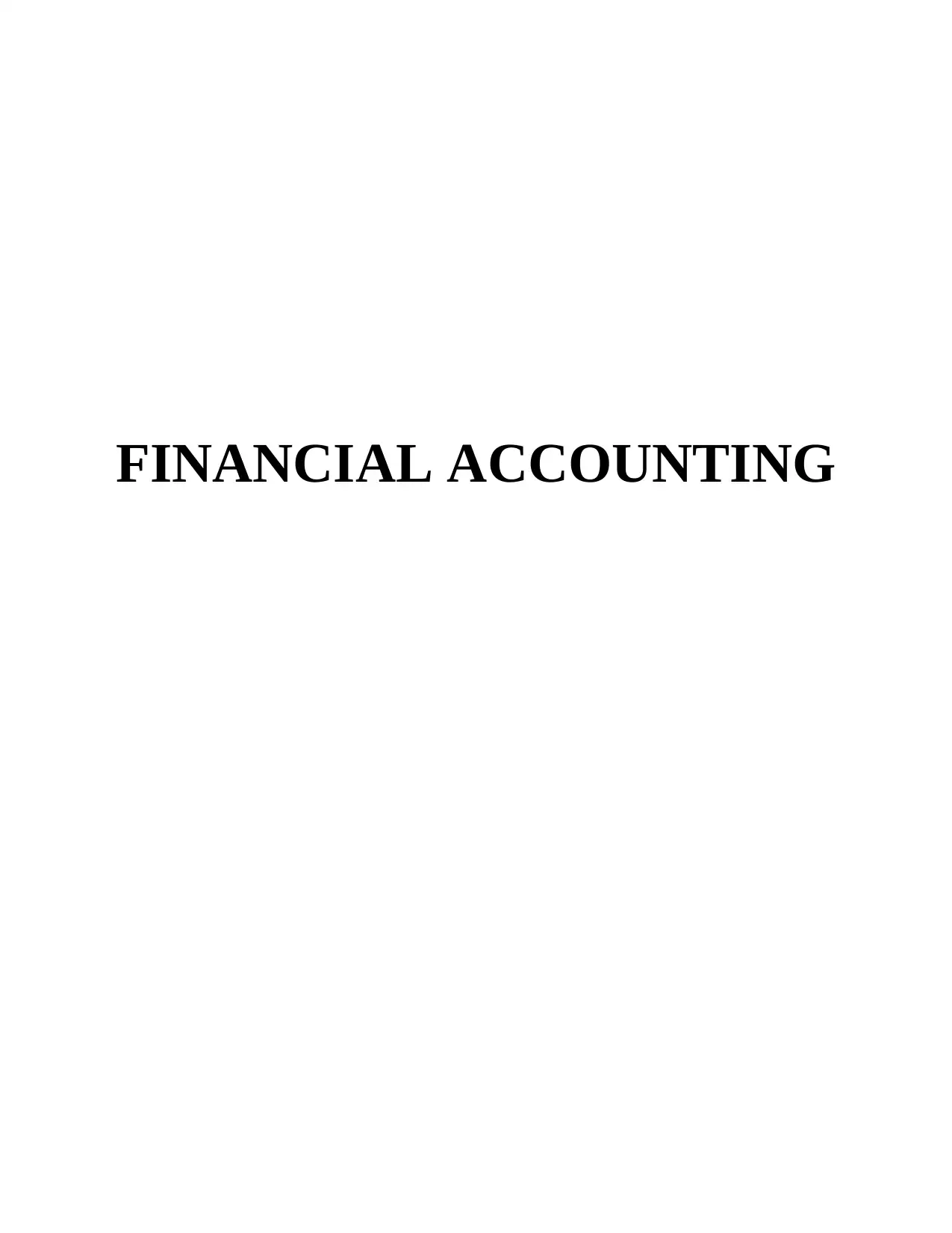
FINANCIAL ACCOUNTING
Paraphrase This Document
Need a fresh take? Get an instant paraphrase of this document with our AI Paraphraser
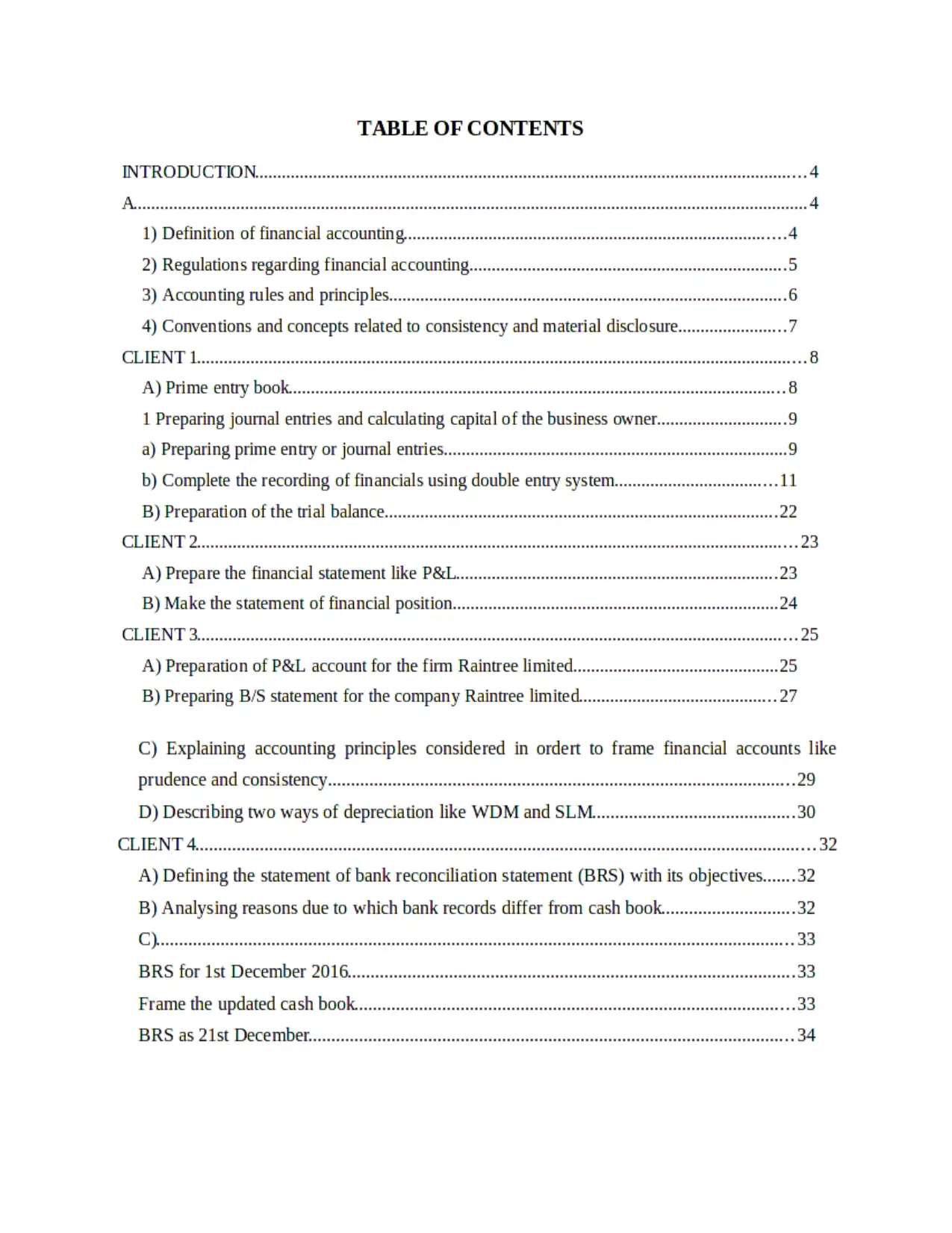
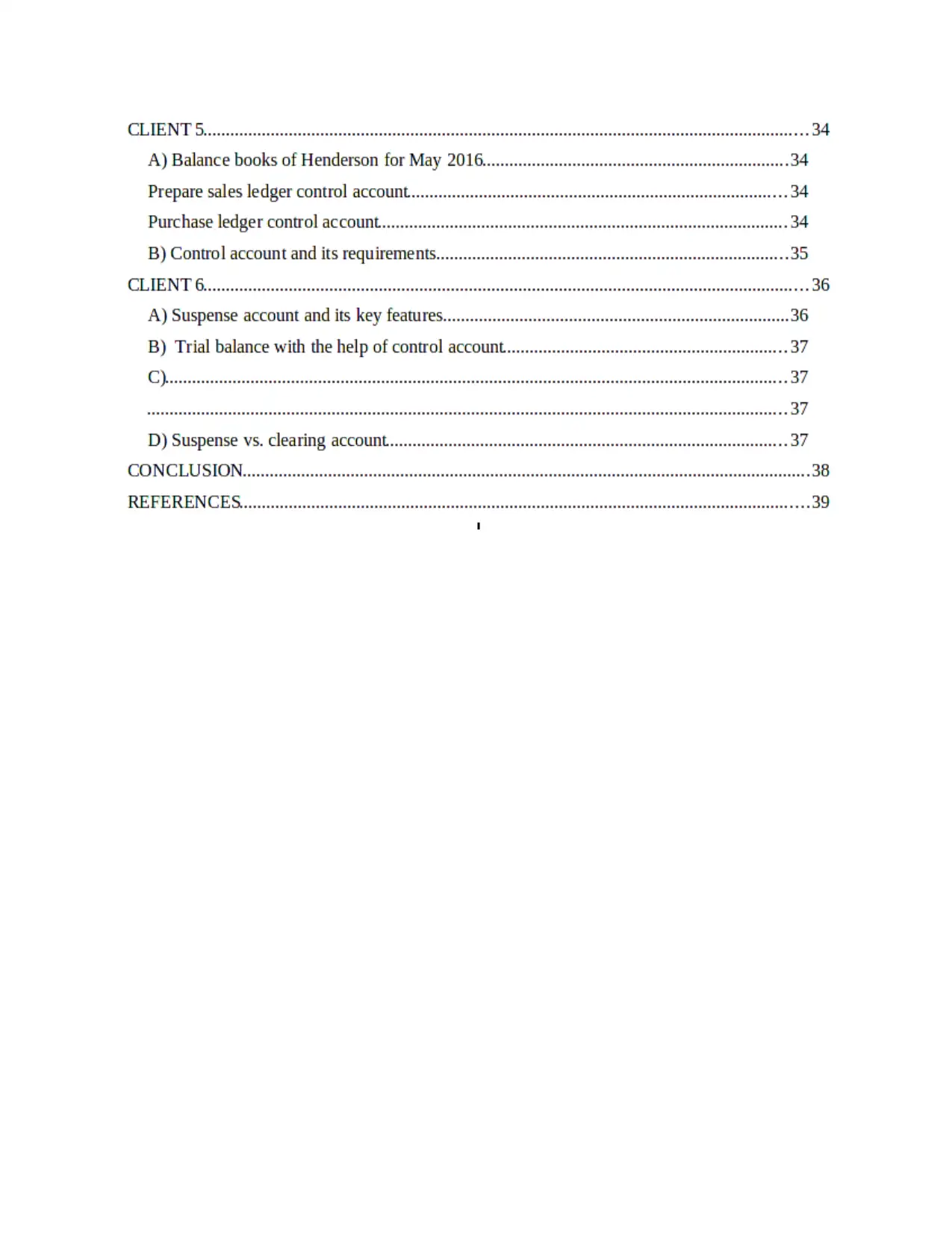
⊘ This is a preview!⊘
Do you want full access?
Subscribe today to unlock all pages.

Trusted by 1+ million students worldwide
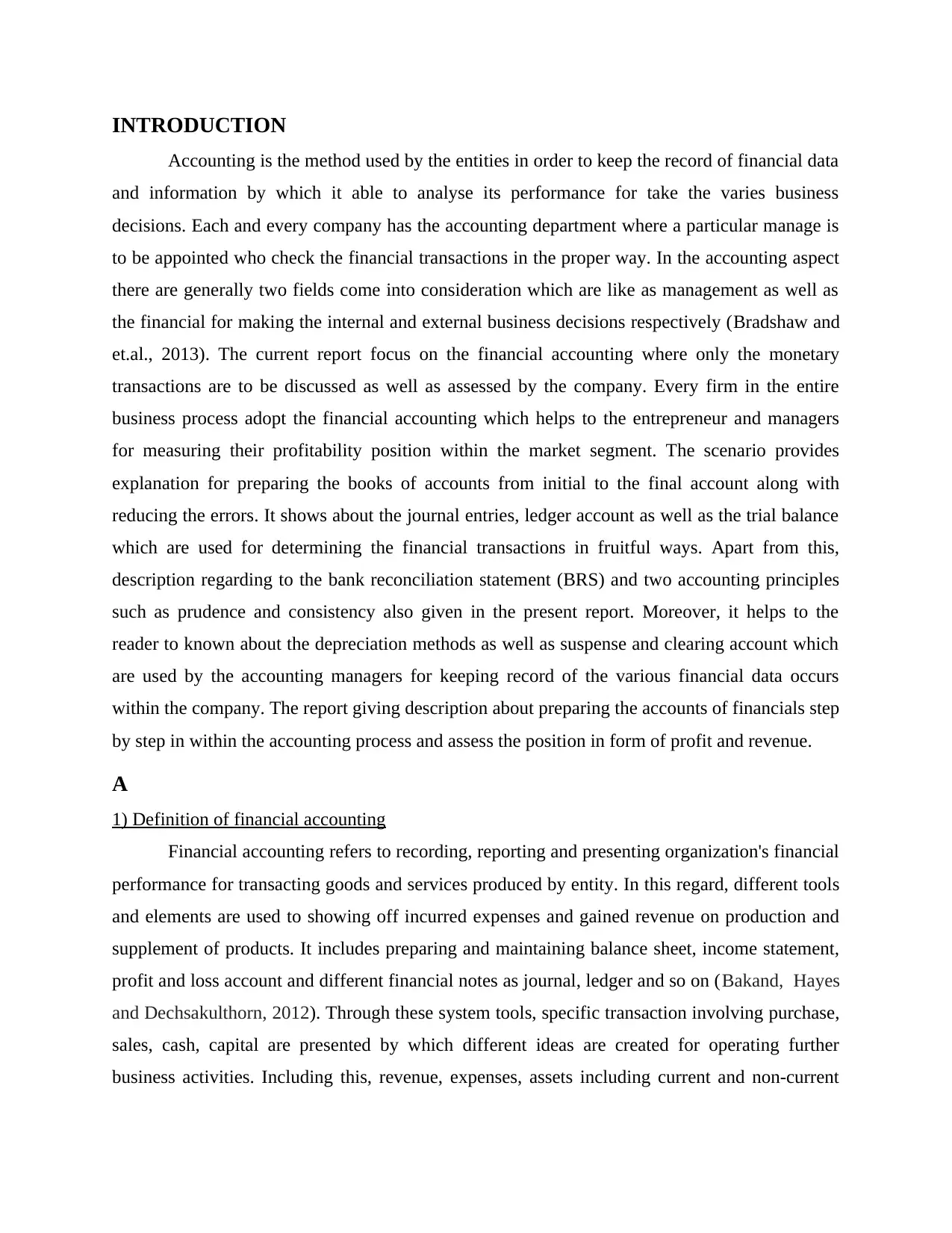
INTRODUCTION
Accounting is the method used by the entities in order to keep the record of financial data
and information by which it able to analyse its performance for take the varies business
decisions. Each and every company has the accounting department where a particular manage is
to be appointed who check the financial transactions in the proper way. In the accounting aspect
there are generally two fields come into consideration which are like as management as well as
the financial for making the internal and external business decisions respectively (Bradshaw and
et.al., 2013). The current report focus on the financial accounting where only the monetary
transactions are to be discussed as well as assessed by the company. Every firm in the entire
business process adopt the financial accounting which helps to the entrepreneur and managers
for measuring their profitability position within the market segment. The scenario provides
explanation for preparing the books of accounts from initial to the final account along with
reducing the errors. It shows about the journal entries, ledger account as well as the trial balance
which are used for determining the financial transactions in fruitful ways. Apart from this,
description regarding to the bank reconciliation statement (BRS) and two accounting principles
such as prudence and consistency also given in the present report. Moreover, it helps to the
reader to known about the depreciation methods as well as suspense and clearing account which
are used by the accounting managers for keeping record of the various financial data occurs
within the company. The report giving description about preparing the accounts of financials step
by step in within the accounting process and assess the position in form of profit and revenue.
A
1) Definition of financial accounting
Financial accounting refers to recording, reporting and presenting organization's financial
performance for transacting goods and services produced by entity. In this regard, different tools
and elements are used to showing off incurred expenses and gained revenue on production and
supplement of products. It includes preparing and maintaining balance sheet, income statement,
profit and loss account and different financial notes as journal, ledger and so on (Bakand, Hayes
and Dechsakulthorn, 2012). Through these system tools, specific transaction involving purchase,
sales, cash, capital are presented by which different ideas are created for operating further
business activities. Including this, revenue, expenses, assets including current and non-current
Accounting is the method used by the entities in order to keep the record of financial data
and information by which it able to analyse its performance for take the varies business
decisions. Each and every company has the accounting department where a particular manage is
to be appointed who check the financial transactions in the proper way. In the accounting aspect
there are generally two fields come into consideration which are like as management as well as
the financial for making the internal and external business decisions respectively (Bradshaw and
et.al., 2013). The current report focus on the financial accounting where only the monetary
transactions are to be discussed as well as assessed by the company. Every firm in the entire
business process adopt the financial accounting which helps to the entrepreneur and managers
for measuring their profitability position within the market segment. The scenario provides
explanation for preparing the books of accounts from initial to the final account along with
reducing the errors. It shows about the journal entries, ledger account as well as the trial balance
which are used for determining the financial transactions in fruitful ways. Apart from this,
description regarding to the bank reconciliation statement (BRS) and two accounting principles
such as prudence and consistency also given in the present report. Moreover, it helps to the
reader to known about the depreciation methods as well as suspense and clearing account which
are used by the accounting managers for keeping record of the various financial data occurs
within the company. The report giving description about preparing the accounts of financials step
by step in within the accounting process and assess the position in form of profit and revenue.
A
1) Definition of financial accounting
Financial accounting refers to recording, reporting and presenting organization's financial
performance for transacting goods and services produced by entity. In this regard, different tools
and elements are used to showing off incurred expenses and gained revenue on production and
supplement of products. It includes preparing and maintaining balance sheet, income statement,
profit and loss account and different financial notes as journal, ledger and so on (Bakand, Hayes
and Dechsakulthorn, 2012). Through these system tools, specific transaction involving purchase,
sales, cash, capital are presented by which different ideas are created for operating further
business activities. Including this, revenue, expenses, assets including current and non-current
Paraphrase This Document
Need a fresh take? Get an instant paraphrase of this document with our AI Paraphraser
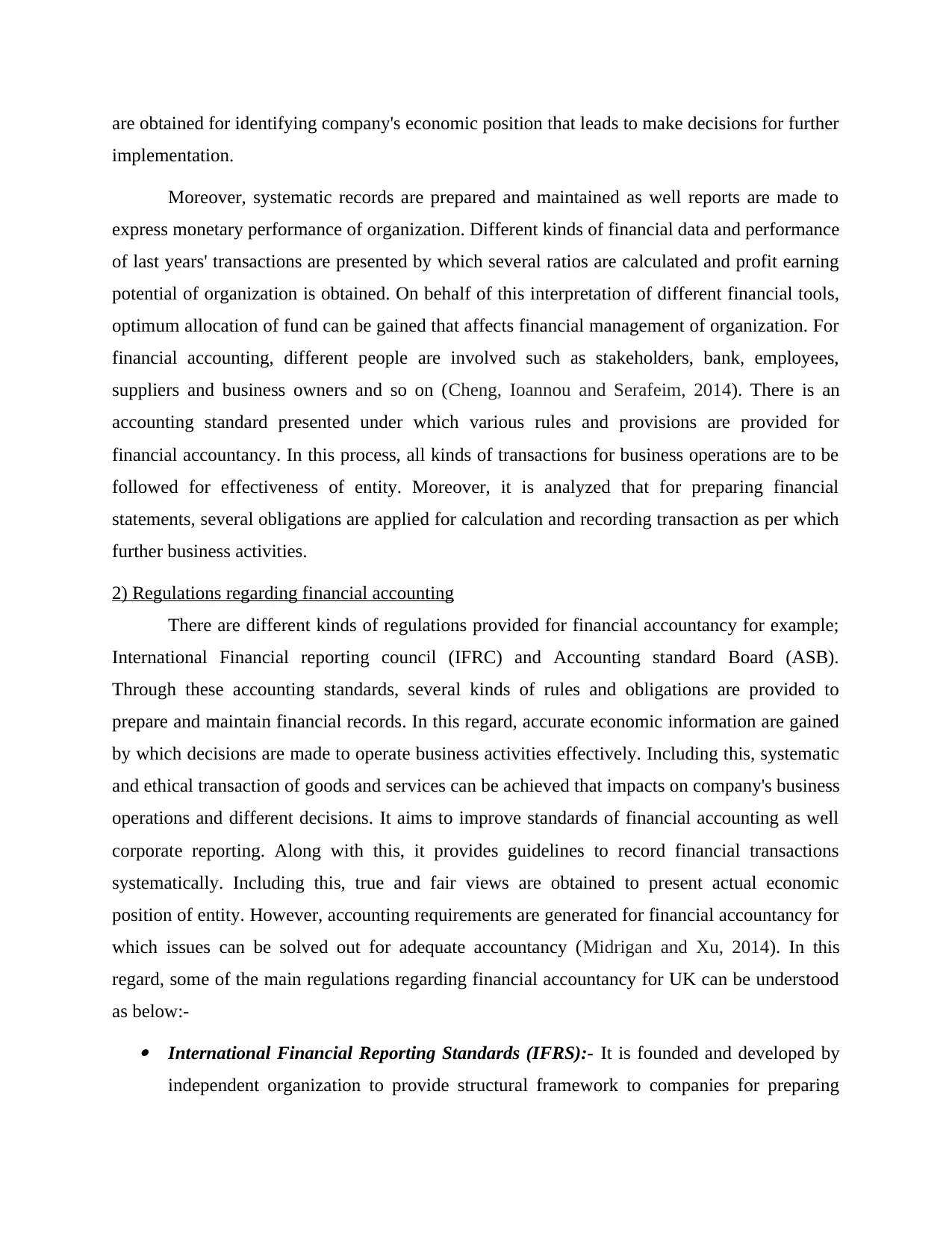
are obtained for identifying company's economic position that leads to make decisions for further
implementation.
Moreover, systematic records are prepared and maintained as well reports are made to
express monetary performance of organization. Different kinds of financial data and performance
of last years' transactions are presented by which several ratios are calculated and profit earning
potential of organization is obtained. On behalf of this interpretation of different financial tools,
optimum allocation of fund can be gained that affects financial management of organization. For
financial accounting, different people are involved such as stakeholders, bank, employees,
suppliers and business owners and so on (Cheng, Ioannou and Serafeim, 2014). There is an
accounting standard presented under which various rules and provisions are provided for
financial accountancy. In this process, all kinds of transactions for business operations are to be
followed for effectiveness of entity. Moreover, it is analyzed that for preparing financial
statements, several obligations are applied for calculation and recording transaction as per which
further business activities.
2) Regulations regarding financial accounting
There are different kinds of regulations provided for financial accountancy for example;
International Financial reporting council (IFRC) and Accounting standard Board (ASB).
Through these accounting standards, several kinds of rules and obligations are provided to
prepare and maintain financial records. In this regard, accurate economic information are gained
by which decisions are made to operate business activities effectively. Including this, systematic
and ethical transaction of goods and services can be achieved that impacts on company's business
operations and different decisions. It aims to improve standards of financial accounting as well
corporate reporting. Along with this, it provides guidelines to record financial transactions
systematically. Including this, true and fair views are obtained to present actual economic
position of entity. However, accounting requirements are generated for financial accountancy for
which issues can be solved out for adequate accountancy (Midrigan and Xu, 2014). In this
regard, some of the main regulations regarding financial accountancy for UK can be understood
as below:- International Financial Reporting Standards (IFRS):- It is founded and developed by
independent organization to provide structural framework to companies for preparing
implementation.
Moreover, systematic records are prepared and maintained as well reports are made to
express monetary performance of organization. Different kinds of financial data and performance
of last years' transactions are presented by which several ratios are calculated and profit earning
potential of organization is obtained. On behalf of this interpretation of different financial tools,
optimum allocation of fund can be gained that affects financial management of organization. For
financial accounting, different people are involved such as stakeholders, bank, employees,
suppliers and business owners and so on (Cheng, Ioannou and Serafeim, 2014). There is an
accounting standard presented under which various rules and provisions are provided for
financial accountancy. In this process, all kinds of transactions for business operations are to be
followed for effectiveness of entity. Moreover, it is analyzed that for preparing financial
statements, several obligations are applied for calculation and recording transaction as per which
further business activities.
2) Regulations regarding financial accounting
There are different kinds of regulations provided for financial accountancy for example;
International Financial reporting council (IFRC) and Accounting standard Board (ASB).
Through these accounting standards, several kinds of rules and obligations are provided to
prepare and maintain financial records. In this regard, accurate economic information are gained
by which decisions are made to operate business activities effectively. Including this, systematic
and ethical transaction of goods and services can be achieved that impacts on company's business
operations and different decisions. It aims to improve standards of financial accounting as well
corporate reporting. Along with this, it provides guidelines to record financial transactions
systematically. Including this, true and fair views are obtained to present actual economic
position of entity. However, accounting requirements are generated for financial accountancy for
which issues can be solved out for adequate accountancy (Midrigan and Xu, 2014). In this
regard, some of the main regulations regarding financial accountancy for UK can be understood
as below:- International Financial Reporting Standards (IFRS):- It is founded and developed by
independent organization to provide structural framework to companies for preparing
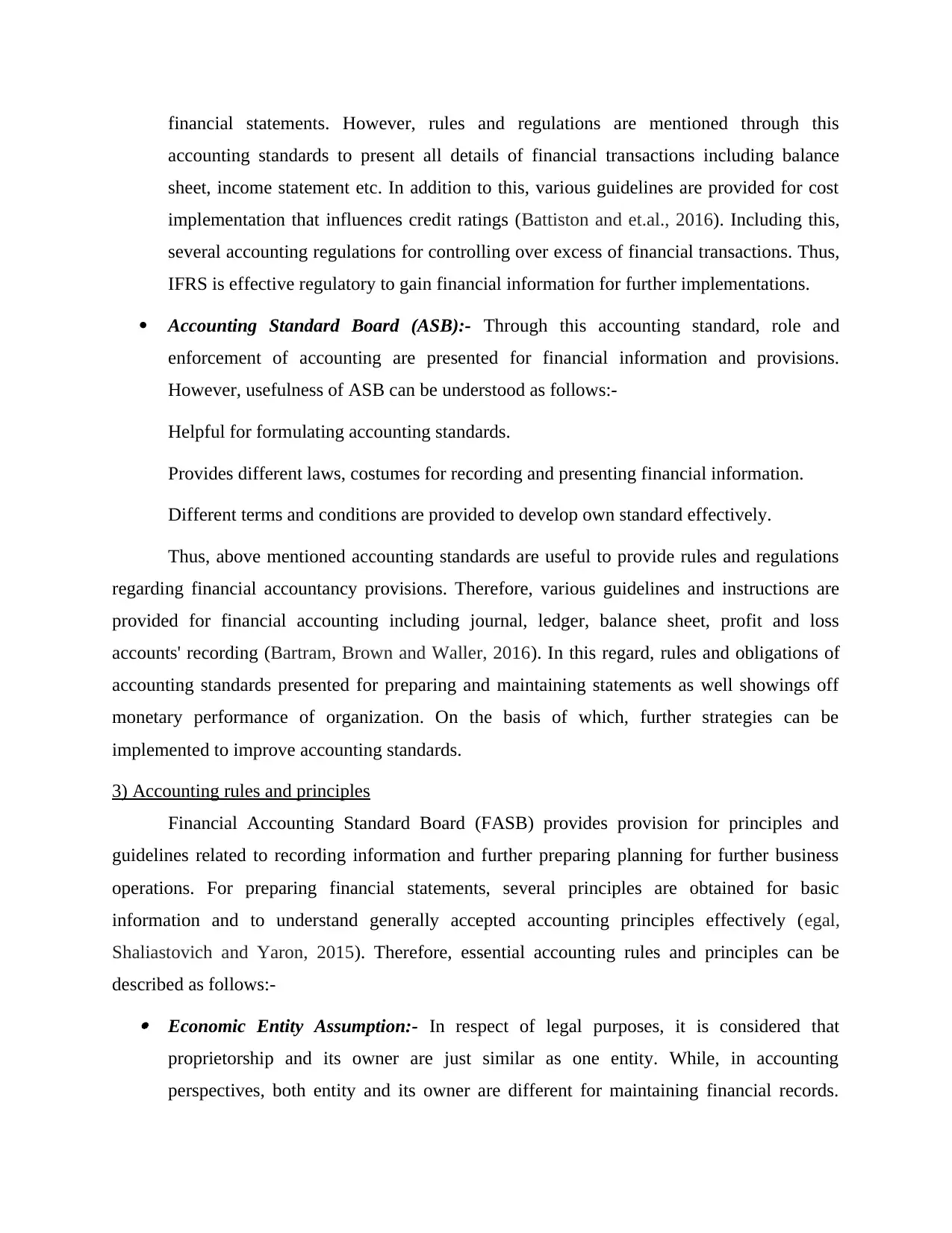
financial statements. However, rules and regulations are mentioned through this
accounting standards to present all details of financial transactions including balance
sheet, income statement etc. In addition to this, various guidelines are provided for cost
implementation that influences credit ratings (Battiston and et.al., 2016). Including this,
several accounting regulations for controlling over excess of financial transactions. Thus,
IFRS is effective regulatory to gain financial information for further implementations.
Accounting Standard Board (ASB):- Through this accounting standard, role and
enforcement of accounting are presented for financial information and provisions.
However, usefulness of ASB can be understood as follows:-
Helpful for formulating accounting standards.
Provides different laws, costumes for recording and presenting financial information.
Different terms and conditions are provided to develop own standard effectively.
Thus, above mentioned accounting standards are useful to provide rules and regulations
regarding financial accountancy provisions. Therefore, various guidelines and instructions are
provided for financial accounting including journal, ledger, balance sheet, profit and loss
accounts' recording (Bartram, Brown and Waller, 2016). In this regard, rules and obligations of
accounting standards presented for preparing and maintaining statements as well showings off
monetary performance of organization. On the basis of which, further strategies can be
implemented to improve accounting standards.
3) Accounting rules and principles
Financial Accounting Standard Board (FASB) provides provision for principles and
guidelines related to recording information and further preparing planning for further business
operations. For preparing financial statements, several principles are obtained for basic
information and to understand generally accepted accounting principles effectively (egal,
Shaliastovich and Yaron, 2015). Therefore, essential accounting rules and principles can be
described as follows:- Economic Entity Assumption:- In respect of legal purposes, it is considered that
proprietorship and its owner are just similar as one entity. While, in accounting
perspectives, both entity and its owner are different for maintaining financial records.
accounting standards to present all details of financial transactions including balance
sheet, income statement etc. In addition to this, various guidelines are provided for cost
implementation that influences credit ratings (Battiston and et.al., 2016). Including this,
several accounting regulations for controlling over excess of financial transactions. Thus,
IFRS is effective regulatory to gain financial information for further implementations.
Accounting Standard Board (ASB):- Through this accounting standard, role and
enforcement of accounting are presented for financial information and provisions.
However, usefulness of ASB can be understood as follows:-
Helpful for formulating accounting standards.
Provides different laws, costumes for recording and presenting financial information.
Different terms and conditions are provided to develop own standard effectively.
Thus, above mentioned accounting standards are useful to provide rules and regulations
regarding financial accountancy provisions. Therefore, various guidelines and instructions are
provided for financial accounting including journal, ledger, balance sheet, profit and loss
accounts' recording (Bartram, Brown and Waller, 2016). In this regard, rules and obligations of
accounting standards presented for preparing and maintaining statements as well showings off
monetary performance of organization. On the basis of which, further strategies can be
implemented to improve accounting standards.
3) Accounting rules and principles
Financial Accounting Standard Board (FASB) provides provision for principles and
guidelines related to recording information and further preparing planning for further business
operations. For preparing financial statements, several principles are obtained for basic
information and to understand generally accepted accounting principles effectively (egal,
Shaliastovich and Yaron, 2015). Therefore, essential accounting rules and principles can be
described as follows:- Economic Entity Assumption:- In respect of legal purposes, it is considered that
proprietorship and its owner are just similar as one entity. While, in accounting
perspectives, both entity and its owner are different for maintaining financial records.
⊘ This is a preview!⊘
Do you want full access?
Subscribe today to unlock all pages.

Trusted by 1+ million students worldwide
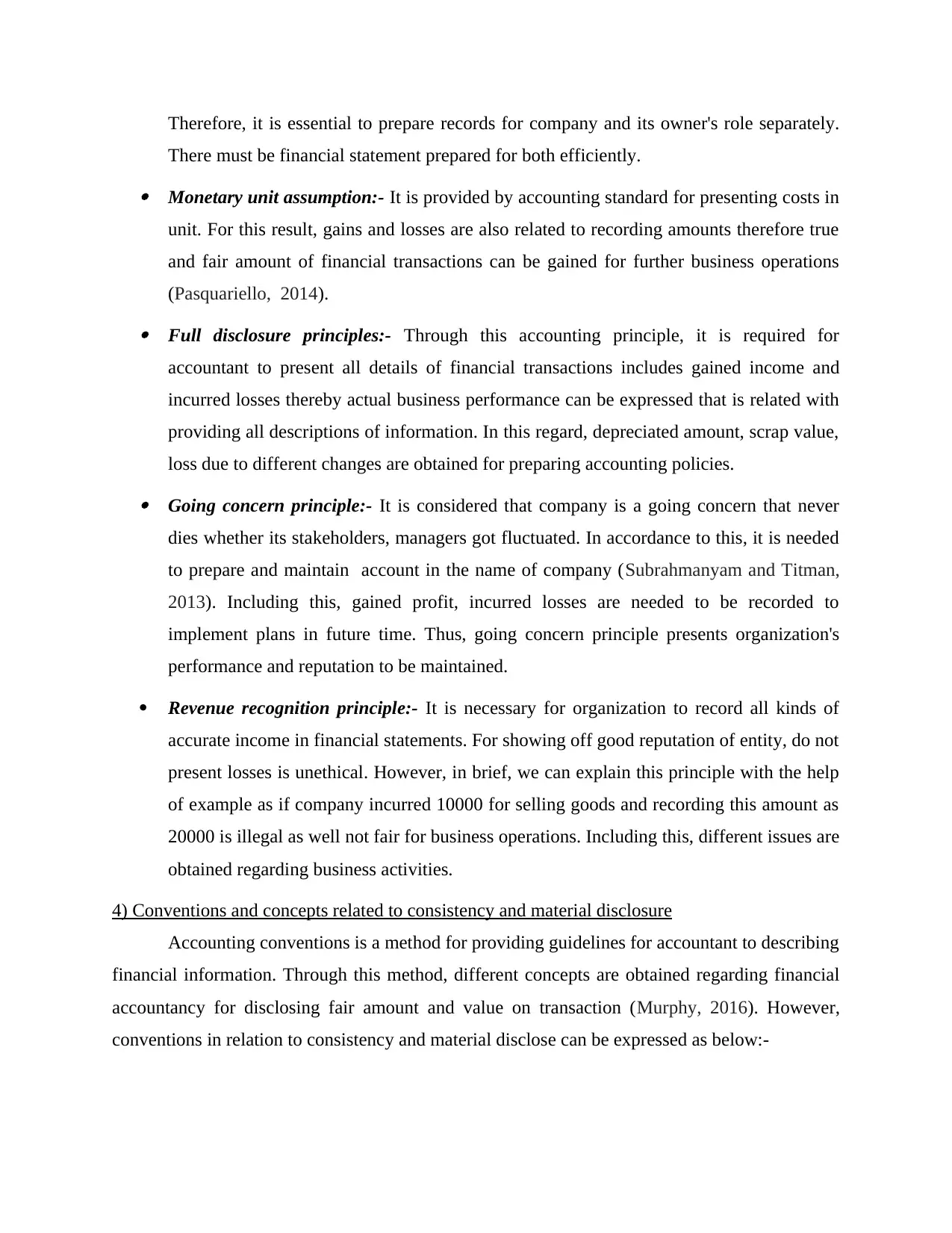
Therefore, it is essential to prepare records for company and its owner's role separately.
There must be financial statement prepared for both efficiently. Monetary unit assumption:- It is provided by accounting standard for presenting costs in
unit. For this result, gains and losses are also related to recording amounts therefore true
and fair amount of financial transactions can be gained for further business operations
(Pasquariello, 2014). Full disclosure principles:- Through this accounting principle, it is required for
accountant to present all details of financial transactions includes gained income and
incurred losses thereby actual business performance can be expressed that is related with
providing all descriptions of information. In this regard, depreciated amount, scrap value,
loss due to different changes are obtained for preparing accounting policies. Going concern principle:- It is considered that company is a going concern that never
dies whether its stakeholders, managers got fluctuated. In accordance to this, it is needed
to prepare and maintain account in the name of company (Subrahmanyam and Titman,
2013). Including this, gained profit, incurred losses are needed to be recorded to
implement plans in future time. Thus, going concern principle presents organization's
performance and reputation to be maintained.
Revenue recognition principle:- It is necessary for organization to record all kinds of
accurate income in financial statements. For showing off good reputation of entity, do not
present losses is unethical. However, in brief, we can explain this principle with the help
of example as if company incurred 10000 for selling goods and recording this amount as
20000 is illegal as well not fair for business operations. Including this, different issues are
obtained regarding business activities.
4) Conventions and concepts related to consistency and material disclosure
Accounting conventions is a method for providing guidelines for accountant to describing
financial information. Through this method, different concepts are obtained regarding financial
accountancy for disclosing fair amount and value on transaction (Murphy, 2016). However,
conventions in relation to consistency and material disclose can be expressed as below:-
There must be financial statement prepared for both efficiently. Monetary unit assumption:- It is provided by accounting standard for presenting costs in
unit. For this result, gains and losses are also related to recording amounts therefore true
and fair amount of financial transactions can be gained for further business operations
(Pasquariello, 2014). Full disclosure principles:- Through this accounting principle, it is required for
accountant to present all details of financial transactions includes gained income and
incurred losses thereby actual business performance can be expressed that is related with
providing all descriptions of information. In this regard, depreciated amount, scrap value,
loss due to different changes are obtained for preparing accounting policies. Going concern principle:- It is considered that company is a going concern that never
dies whether its stakeholders, managers got fluctuated. In accordance to this, it is needed
to prepare and maintain account in the name of company (Subrahmanyam and Titman,
2013). Including this, gained profit, incurred losses are needed to be recorded to
implement plans in future time. Thus, going concern principle presents organization's
performance and reputation to be maintained.
Revenue recognition principle:- It is necessary for organization to record all kinds of
accurate income in financial statements. For showing off good reputation of entity, do not
present losses is unethical. However, in brief, we can explain this principle with the help
of example as if company incurred 10000 for selling goods and recording this amount as
20000 is illegal as well not fair for business operations. Including this, different issues are
obtained regarding business activities.
4) Conventions and concepts related to consistency and material disclosure
Accounting conventions is a method for providing guidelines for accountant to describing
financial information. Through this method, different concepts are obtained regarding financial
accountancy for disclosing fair amount and value on transaction (Murphy, 2016). However,
conventions in relation to consistency and material disclose can be expressed as below:-
Paraphrase This Document
Need a fresh take? Get an instant paraphrase of this document with our AI Paraphraser
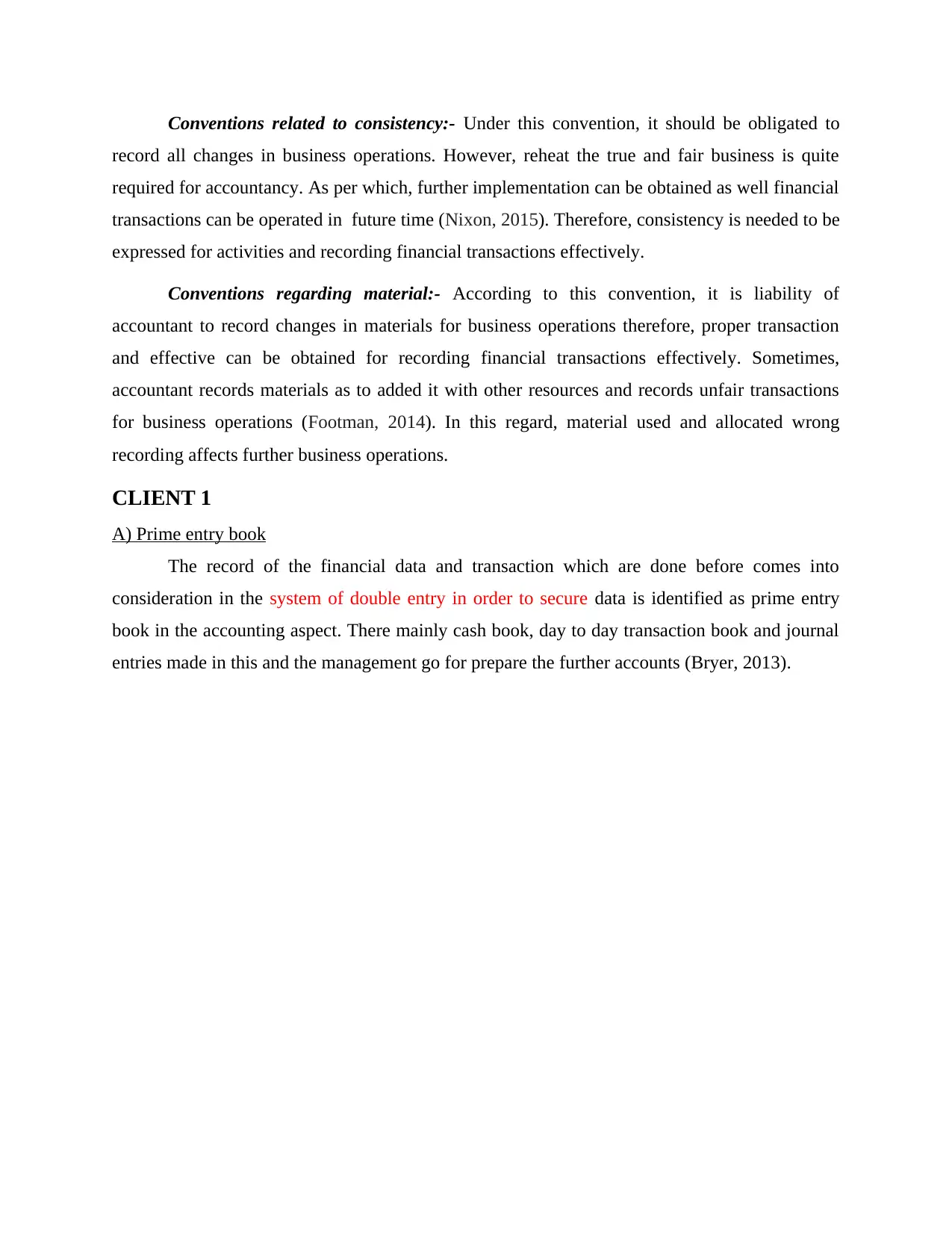
Conventions related to consistency:- Under this convention, it should be obligated to
record all changes in business operations. However, reheat the true and fair business is quite
required for accountancy. As per which, further implementation can be obtained as well financial
transactions can be operated in future time (Nixon, 2015). Therefore, consistency is needed to be
expressed for activities and recording financial transactions effectively.
Conventions regarding material:- According to this convention, it is liability of
accountant to record changes in materials for business operations therefore, proper transaction
and effective can be obtained for recording financial transactions effectively. Sometimes,
accountant records materials as to added it with other resources and records unfair transactions
for business operations (Footman, 2014). In this regard, material used and allocated wrong
recording affects further business operations.
CLIENT 1
A) Prime entry book
The record of the financial data and transaction which are done before comes into
consideration in the system of double entry in order to secure data is identified as prime entry
book in the accounting aspect. There mainly cash book, day to day transaction book and journal
entries made in this and the management go for prepare the further accounts (Bryer, 2013).
record all changes in business operations. However, reheat the true and fair business is quite
required for accountancy. As per which, further implementation can be obtained as well financial
transactions can be operated in future time (Nixon, 2015). Therefore, consistency is needed to be
expressed for activities and recording financial transactions effectively.
Conventions regarding material:- According to this convention, it is liability of
accountant to record changes in materials for business operations therefore, proper transaction
and effective can be obtained for recording financial transactions effectively. Sometimes,
accountant records materials as to added it with other resources and records unfair transactions
for business operations (Footman, 2014). In this regard, material used and allocated wrong
recording affects further business operations.
CLIENT 1
A) Prime entry book
The record of the financial data and transaction which are done before comes into
consideration in the system of double entry in order to secure data is identified as prime entry
book in the accounting aspect. There mainly cash book, day to day transaction book and journal
entries made in this and the management go for prepare the further accounts (Bryer, 2013).
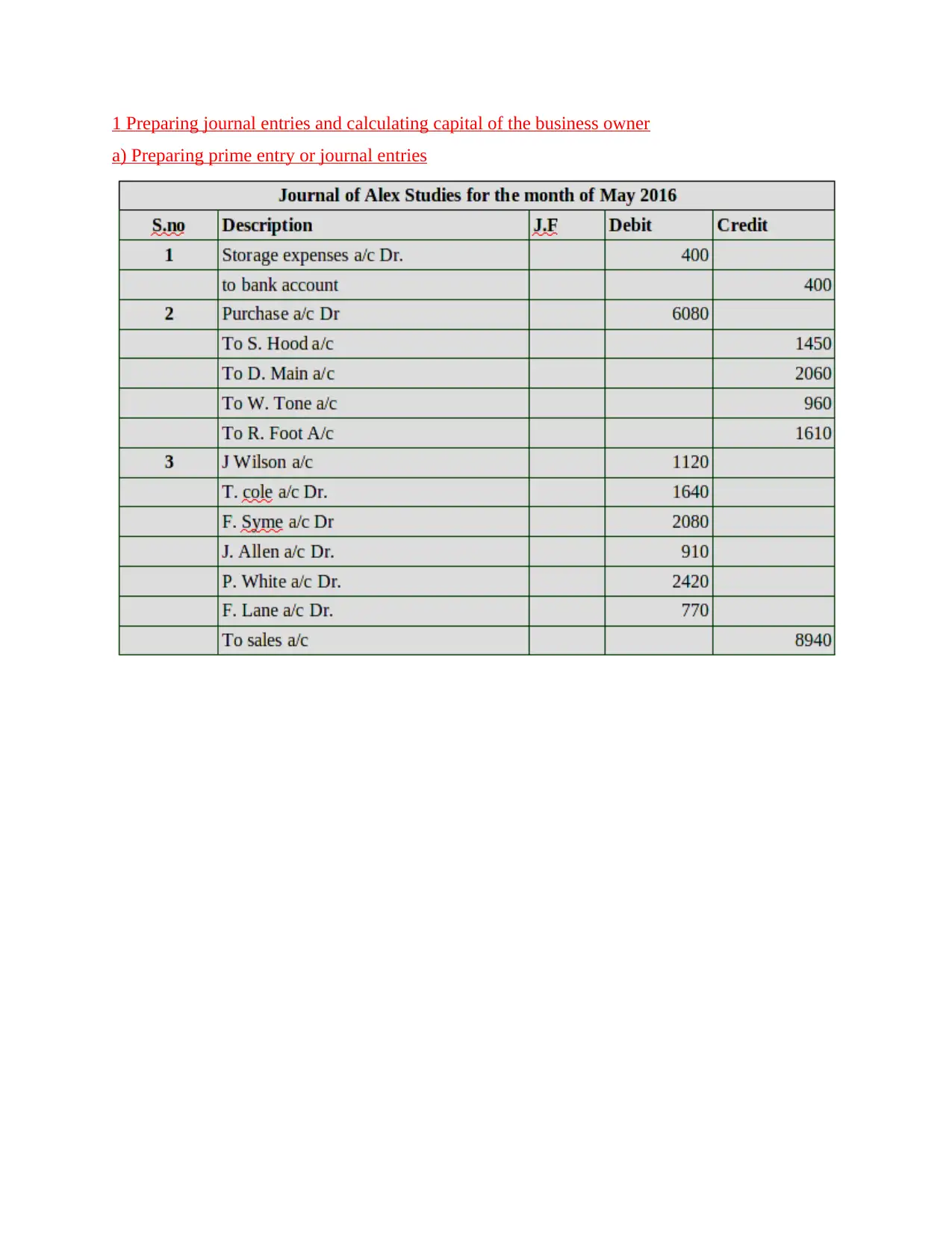
1 Preparing journal entries and calculating capital of the business owner
a) Preparing prime entry or journal entries
a) Preparing prime entry or journal entries
⊘ This is a preview!⊘
Do you want full access?
Subscribe today to unlock all pages.

Trusted by 1+ million students worldwide
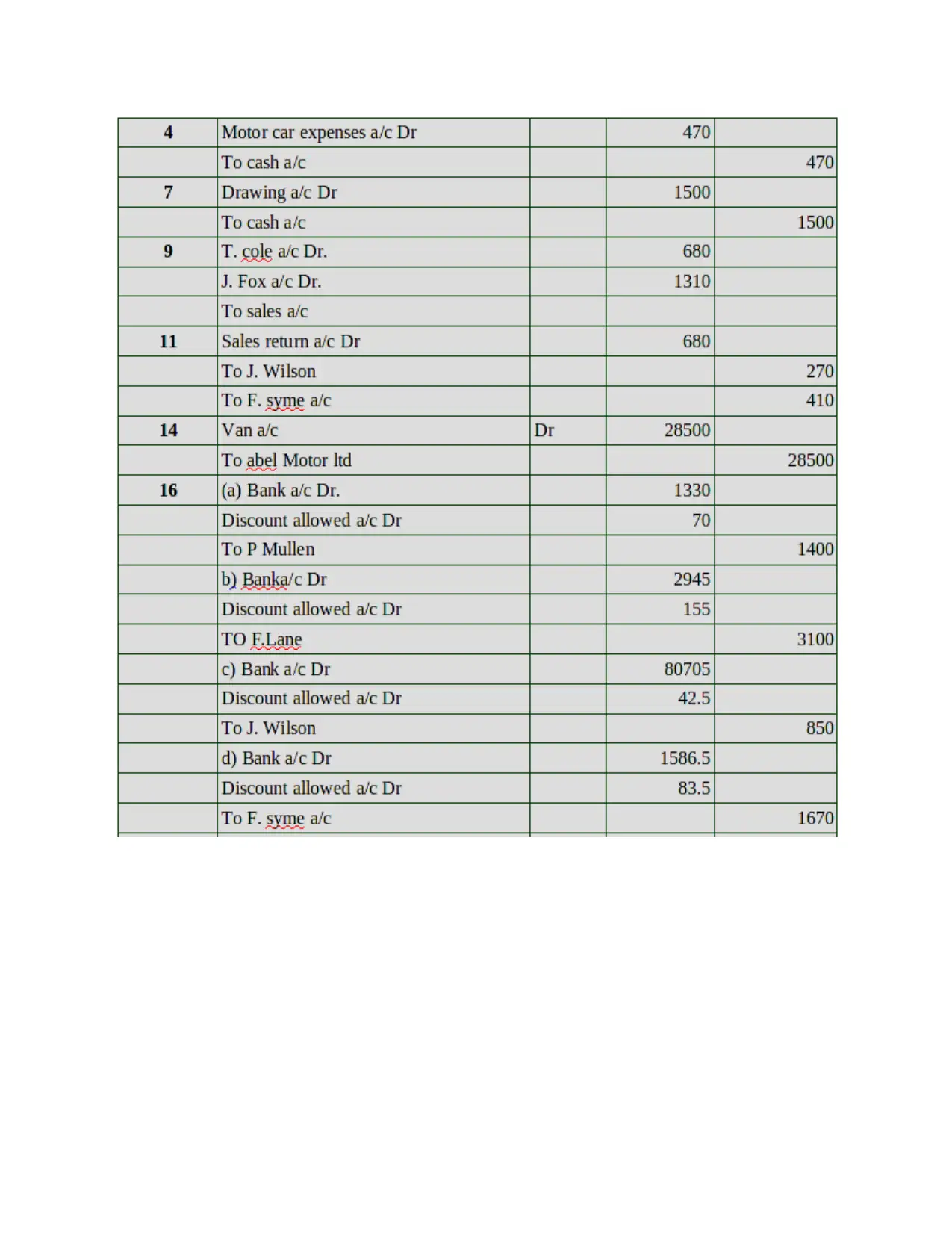
Paraphrase This Document
Need a fresh take? Get an instant paraphrase of this document with our AI Paraphraser
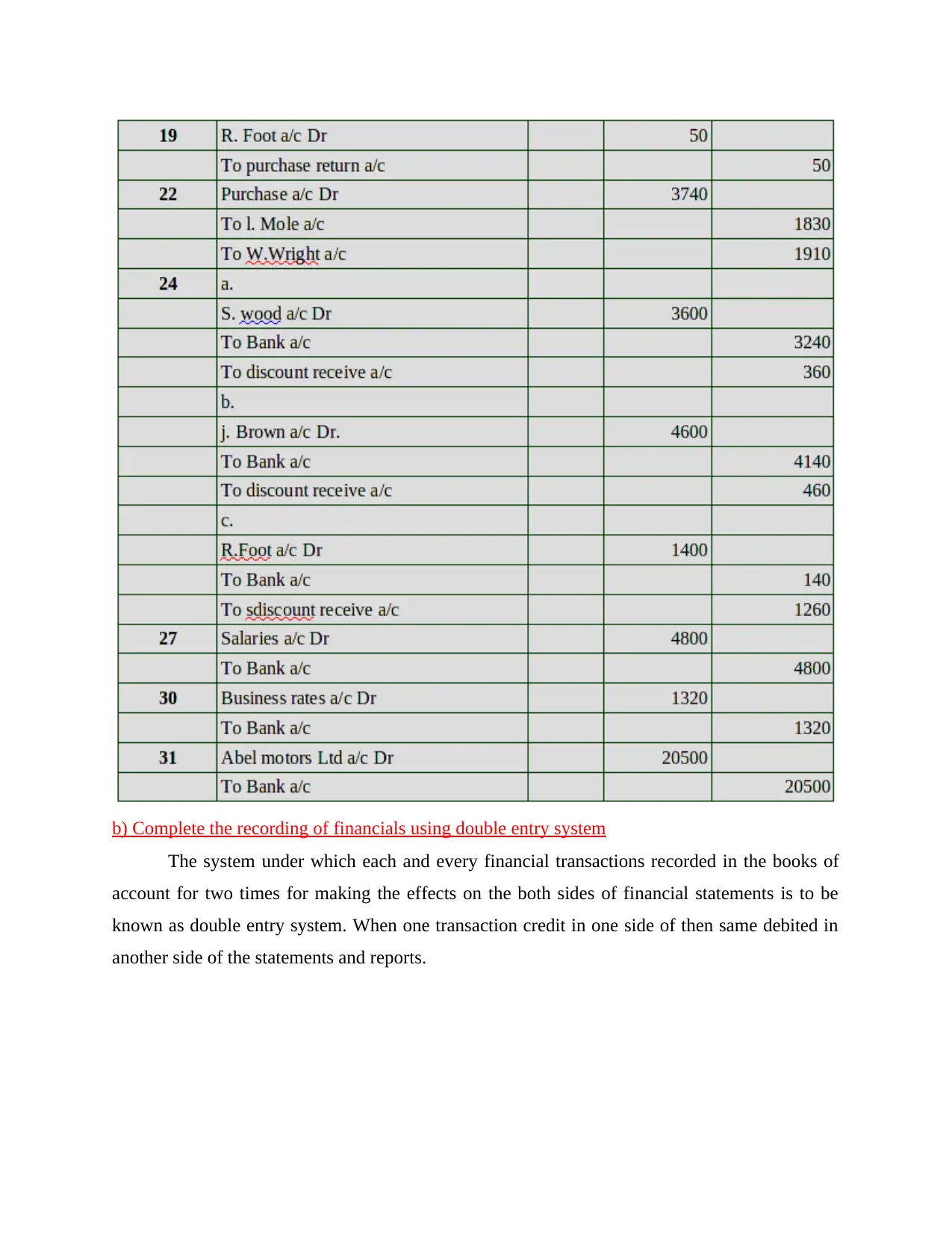
b) Complete the recording of financials using double entry system
The system under which each and every financial transactions recorded in the books of
account for two times for making the effects on the both sides of financial statements is to be
known as double entry system. When one transaction credit in one side of then same debited in
another side of the statements and reports.
The system under which each and every financial transactions recorded in the books of
account for two times for making the effects on the both sides of financial statements is to be
known as double entry system. When one transaction credit in one side of then same debited in
another side of the statements and reports.
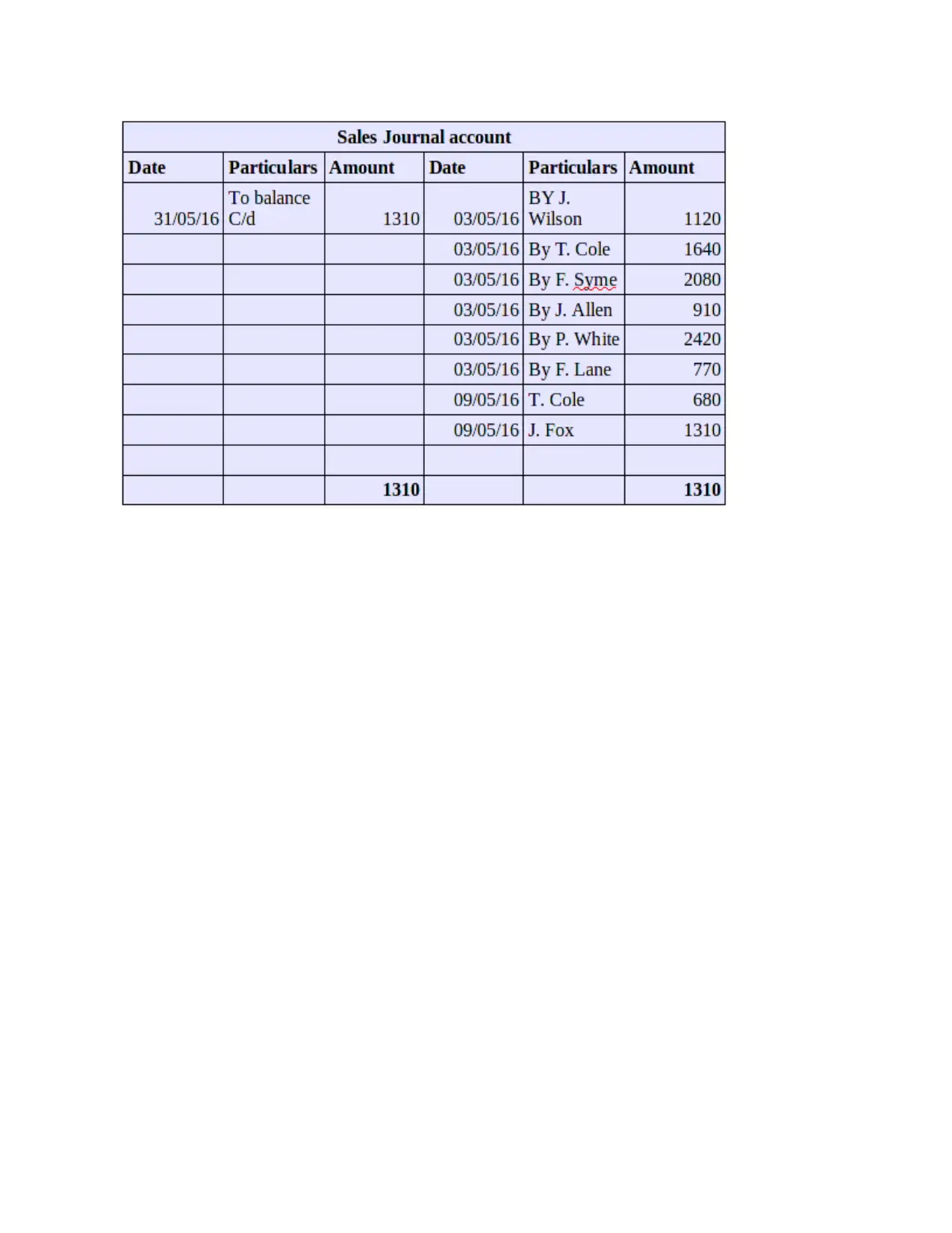
⊘ This is a preview!⊘
Do you want full access?
Subscribe today to unlock all pages.

Trusted by 1+ million students worldwide
1 out of 41
Related Documents
Your All-in-One AI-Powered Toolkit for Academic Success.
+13062052269
info@desklib.com
Available 24*7 on WhatsApp / Email
![[object Object]](/_next/static/media/star-bottom.7253800d.svg)
Unlock your academic potential
Copyright © 2020–2025 A2Z Services. All Rights Reserved. Developed and managed by ZUCOL.





